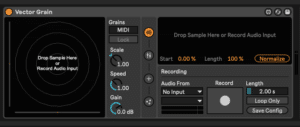Vector Grain and Tree Tone
Vector Grain and Tree Tone
Vector Grain and Tree Tone, are also devices from the M4L Pack “Inspired by Nature by Dillon Bastan“.
Vector Grain is a granular synthesizer t that allows you to manipulate samples by breaking them down into small grains and then manipulating them in various ways. You can adjust the pitch, speed, grain size, and other parameters to create a wide range of sounds, from smooth textures to glitchy effects. In addition there is also an audio effect called Vector Delay.

Besides Vector Grain that we use in this class, you’ll find also two other vector device in the Inspired by Nature Pack:
Vector Delay is a polyphonic delay where each particle would be a delay line.
Vector FM is an FM synthesizer where each particle is an operator or pair of operators depending on settings.
All Vector devices are centred around a particle system that responds to different simulated forces:
Gravity – attraction towards a body with a certain gravitational strength.
Flowfield – a path based on directional forces, which determine the particles’ ability to move left, right, up, down and diagonally.
Magnetism – more specifically, a sort of pseudo-magnetism based on each particle’s charge (really just gravitational attraction between particles).
Each particle represents an individual voice in the device.
Vector Grain
is a granular looper/sampler where each particle would be a sample playback voice/grain.
Vector Map is an organic modulation source where each particle and their properties (size, direction, velocity) can control any automatable parameter in Live.
The different options for forces, mappings, and the possibility of emitting particles (particle creation and destruction in regular intervals) allow for a large variety of results both simple and
complex. Particle attributes like position, size, and speed, can modulate the audio parameters using the modulation knobs at the bottom of the first page of each Vector device.
Audio Settings Page:
Here you can find the controls for each of the sound engines, as well as the modulation attenuators and filter/panning.
Force Settings Page:
From this page, you can control the forces of the particle system. By selecting the different color options (charge), you can determine which particles are affected by which force. The balance of charged particles (i.e. more negative than positive or vice versa) can be determined on the Particle Settings page using the ‘Charge’ slider.
Particle Settings Page:
Here you can control the parameters for the particle settings (such as charge or mass) and the particle Emitter. When the emitter is on, particles will be created and destroyed (instead of
continuously existing). This allows for more rhythmic possibilities, among other outcomes.
Tree Tone
is a resonator that uses a complex algorithm to create natural-sounding tones. It is based on the idea that many natural sounds are composed of multiple resonances that interact in a complex way. This is reminiscent of what we learned with Physical Modeling synthesis. Tree Tone allows you to create your own resonators by adjusting the parameters and then feeding them with input sounds.
This device leaves the concept of a particle system, yet still simulates nature and physics using vectors pulled in different directions to create branches. The branches are translated into frequency, decay, and amplitude values for a bank of resonant filters (each branch represents a filter) based on the branch’s length and thickness. The result is a resonator whose properties and number of filters are determined by the shape of the tree. Growing different types of trees result in different sounds.
The resonators may also be excited and modulated in a few different ways, by filtered noise, filtered audio input, “plucking” the branches or by using the modulation tab. Additionally there is an audio input tab allowing users to route their own sounds through the resonant filters, or to feedback the sound itself and create resonant feedback tones – especially interesting to do in combo with other effects in the chain before feeding back. It also features a modulation section with two envelopes and two LFOs



